Persian Garden: A Piece of Paradise in Iran
The architecture of a society and the meanings attached to it may serve as a representation of its culture and identity.
In this way, the nation and the next generations are given value and identity via architecture and design. You will discover that Iranians adore going on excursions and spending time in nature when you visit Iran. They will locate a spot to have a picnic in the shade of huge trees, no matter the weather. One of the possible causes for the Persian Garden's emergence and rise to prominence in Iranian urbanism is its appreciation of nature.
Persian Garden History
Persian gardens have a long history that dates back to a few millennia before Islam conquer Iran (Persia). The oldest form of Persian garden architecture, known as Chahar bagh or 4-fold garden design, is found in Pasargadae, the ancient capital of Persia. Climate, art, religion, poetry, literature, and romance of the nation and the location where the garden is located have an impact on each Persian garden’s design.
These gardens were known as Pardis in Persian, which is whence the English word paradise—used to refer to heaven—derives.
Nine of these magnificent private gardens, together known as the Persian gardens, are among Iran’s United Nations Educational, Scientific, and Cultural Organization (UNESCO) World Heritage Sites. In the past, Persian nobility established themselves there. These gardens are notable not just for their visual splendor but also for their capacity to adapt to and thrive in harsh environments. The Iranian plateau is not a place where gardens can develop. Extremely unfavorable weather conditions include little rainfall, extremely hot and dry summers, bitterly cold winters, and strong winds. Therefore, these man-made shelters were dependent on effective space use and an underground watering system (SIS). These gardens have changed over time in terms of design, appearance, and purpose.
| Suggestion: Persian Art
Following the Arab invasion, the old Persian idea of chahar bagh (four gardens), which mirrored the Garden of Eden described in passages of the Koran as a spot where two rivers converge, was employed in Persian landscaping, emphasizing the beauty and dividing the garden into four quadrants. Ornamental and beautiful flower species were brought during the Mongolian invasion in the 13th century. The garden was finally extended by a palace under the Safavid dynasty in the 17th and 18th centuries. In other words, a residence or a pavilion was built on the garden’s property and eventually became a crucial component of the Persian garden.
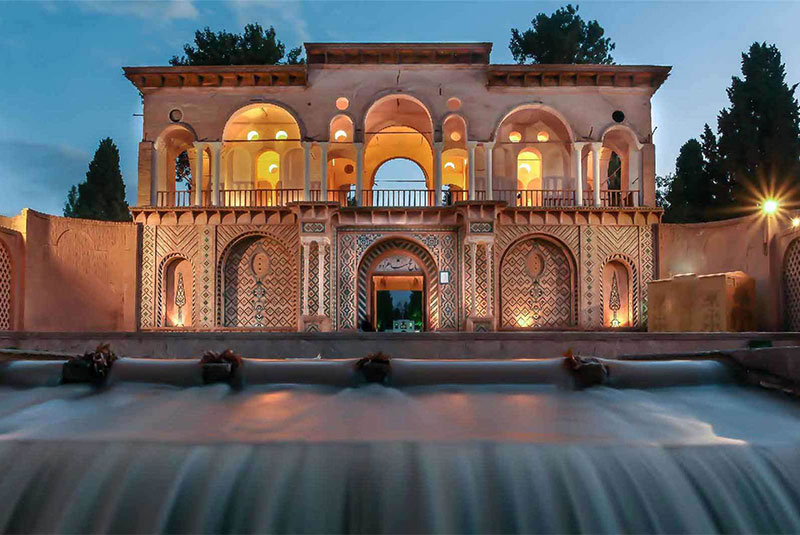
Elements of the Persian Garden
Shade is crucial in gardens because of the dry climate of Iran. As a result, it was crucial to consider the effects of sunlight while designing structures so that textures and forms could be created expressly to manage the light. Natural shade is provided mostly by trees; Iranians have a preference for a variety of fruit trees as well as Black Poplar, Sycamore, Pine, Willow, Maple, Plane Tree, Spruce, and Cypress trees. Walls and pavilions have a significant structural role in hiding the sun. The heat also makes a steady supply of water crucial to the garden’s design and upkeep. These gardens have always been constructed near aqueducts, springs, or Qanats.
In most gardens, water enters from one end to irrigate trees and plants, and leaves from the other end due to the design and structure of the water flow. Additionally, buildings to retain more water in the garden have been built in Iran due to the nation’s appreciation of flowing water. In addition to being beautiful and entertaining, the presence of components like streams, fountains, pools, and ponds had a spectacular cooling effect. Additionally, as plants need irrigation, trees are frequently placed next to a ditch known as a Juy that is connected to the picturesque main streams and gives the tree roots access to water. Typically, houses or pavilions in Iran will include gardens. By linking a surrounding garden with an inside courtyard, Persian architects frequently try to combine the indoors and outside. To bridge the gap between the exterior and internal spaces, architects frequently insert architectural features like vaulted arches.
| Suggestion: Iran's Wildlife | A Nature Lover's Guide + Pics
Note!
People of the Iranian plateau created the Qanat, a brand-new subterranean water delivery system, centuries ago. With the help of this new discovery, large volumes of subterranean water may be accessed and brought to the surface of the ground. This water, like natural springs, can now be brought to the surface year-round without assistance from beneath the earth. Although this network of underground water channels was originally known as Kariz and is believed to have been created in Iran, the term “Qanat” (Ghanat) is Arabic.
Some of the Most Important Features of the Persian Garden are Listed Below:
- Dividing into four sections
- High walls encircle the garden
- Straight lines are used in designs
- Crosswalks and straight, parallel streets
- In the middle or at the top of the garden, there is a pavilion or a house.
- Enhancing the attractiveness of the environment in front of the pavilion by using huge pools for reflection effects
- Utilize a major water canal, which is often fed by a qanat
- Fountains and water streams
| Read more: 16 Most Beautiful Mosques You Should Visit
Persian Gardens on UNESCO World Heritage List
1. Pasargadae Gardens Near Shiraz
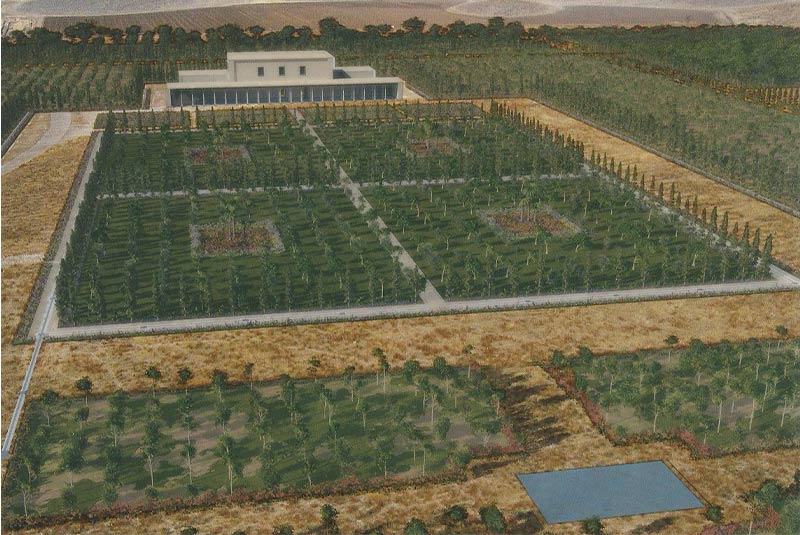
The concept of an earthly paradise initially appeared in Persian literature under the Achaemenid Empire, and Cyrus the Great was the first Iranian to establish a complex of Persian gardens at Pasargadae. In reality, based on the findings from various archeological investigations, it has been suggested that the garden’s mathematical layout and design represent the Persian garden as seen through Cyrus’ eyes.
When Cyrus took control, he constructed a garden palace that was a reflection of the Achaemenid’s authority in Pasargadae and was inspired by Mesopotamian gardens. The older Assyrian gardens were either created alongside palaces or temples or were designed distinct from them. Noting the extensive porches around the grounds, Cyrus’ Gardens were constructed as an addition to the palaces. Three Pavilions (Kushk) make up the composition as a whole and porches around a rectangular enclosure.
Even though the ancient Pasargadae Garden isn’t depicted on any maps or photographs today, excavations in the Pasargadae region have revealed that the Persians—possibly Cyrus the Great himself—designed a beautiful garden there. The “Shahdad Bronze Flag,” which dates from between 3500 and 3200 BC, is the earliest item discovered in the Persian Garden. This metal plate depicts the same pattern of four Iranian gardens, with an image of an ancient goddess and three female ladies seated in a beautiful garden shaped like a checkerboard. Following Cyrus, subsequent Achaemenid monarchs, including Darius, Ardashir II, and Xerxes, started establishing gardens in Susa and other towns, and the Persian garden design spread to other cities.
2. Eram Garden in Shiraz
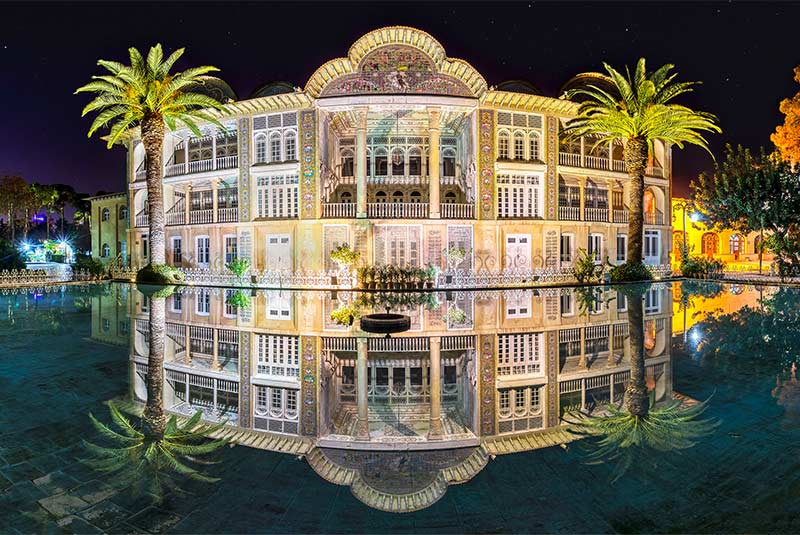
Bagh-e-Eram (Eram Garden), or Eram (Persian meaning paradise or heaven), is a rectangular garden of 110,380 m² with a west-to-east slope that is situated in Shiraz, the capital of the Fars Province in southern Iran, along the northern side of the Khoshk River. There is a central pool, and the main pavilion is on the western side. Although the Seljuk dynasty is credited with starting the garden’s plan in the 11th century, it is likely that the Ilkhanate dynasty was responsible for its construction in the 13th century. A three-story pavilion bordered by colorful mosaics and inscribed with the verses of Persian lyric poet Hafez is reached by water cascading down the blue-tiled fountains and beautiful ponds. The building received renovations by the succeeding Zand and Qajar dynasties, like many other sites in Shiraz.
The garden was handed to the kings of Shiraz during the reign of Nasser al-Din Shah in the Qajar dynasty (19th century), and as a result, Hussein Ali Khan Nasir al-Molk created and established a new mansion. The mansion and garden are now a part of Shiraz’s Botanical Garden. There are several trees that yield both fruit and nonfruit, as well as numerous medicinal plants and innumerable ornamental flowers. Pomegranate, Medlar, Sour Orange, Persimmon, Apple, Pear, Quince, Apricot, Almond, and Persian Walnut are some examples of fruit trees. Iranian cedar, Persian maple, Turkish pine, Pussy Willow, Mountain Ash, Silver Dollar Tree, Weeping Willow, and White Poplar are some of the nonfruit trees.
| Discover: Top Natural Attractions of Iran
3. Chehel Sotoun Palace Garden in Isfahan
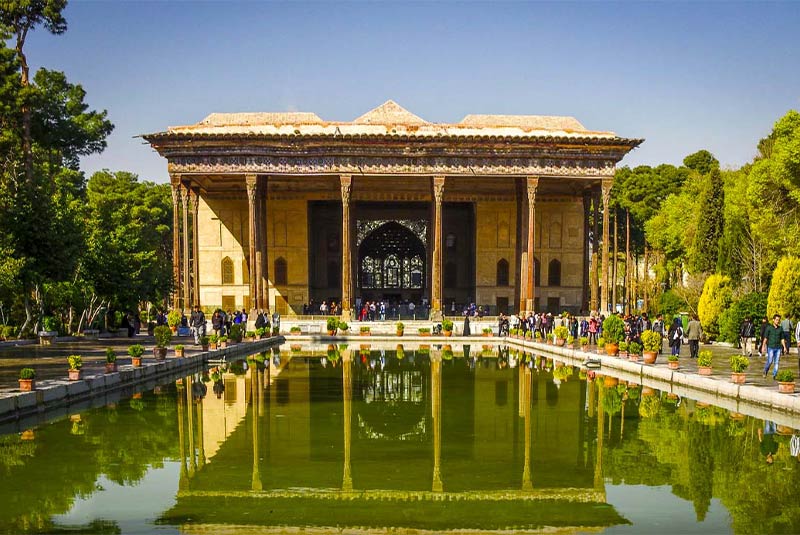
Bagh-e-Chehel Sotun (Chehel Sotoun Garden), a 6.75-hectare garden from the Safavid period, is situated in Isfahan. Twenty thin columns fashioned from the trunks of decorative plane trees adorn the pavilion’s patio. The name of the garden, which translates as “40 columns” in Persian, comes from these columns and their reflection in the big pool in front. These columns are among the landscape’s most striking elements. The Safavid king Shah Abbas I employed civic and urban development to strengthen and establish his empire. In order to win the people’s favor, he was particularly active in building Iranian caravansaries and gardens. The Chehl Sotoun Palace Garden, created by the brilliant Sheikh Baha’i, is an excellent example of Iranian art that is included on the UNESCO World Heritage List.
Shah Abbas I requested the construction of the garden on the southwest side of Isfahan’s Royal Square so that it might serve as a connection between the Royal Square and Chahar Bagh Street. In order to commemorate his coronation, Shah Abbas II erected a palace in the center of an ancient garden. This palace was eventually used as an audience hall for receiving foreign visitors. Turkish pine, Persian elm, Black Maple, Ornamental Plane Tree, Cade Juniper, Iranian Cedar, Forest Boxwood, Norway Maple, White Poplar, Egyptian Acacia, Bay Laurel, and Common Ash are just a few of the plants and trees that can be found at Chehel Sotun Garden.
| Suggestion: Naqsh-e Rustam | Ancient Treasures & Zoroastrian Legacy
4. Dowlat Abad Garden in Yazd
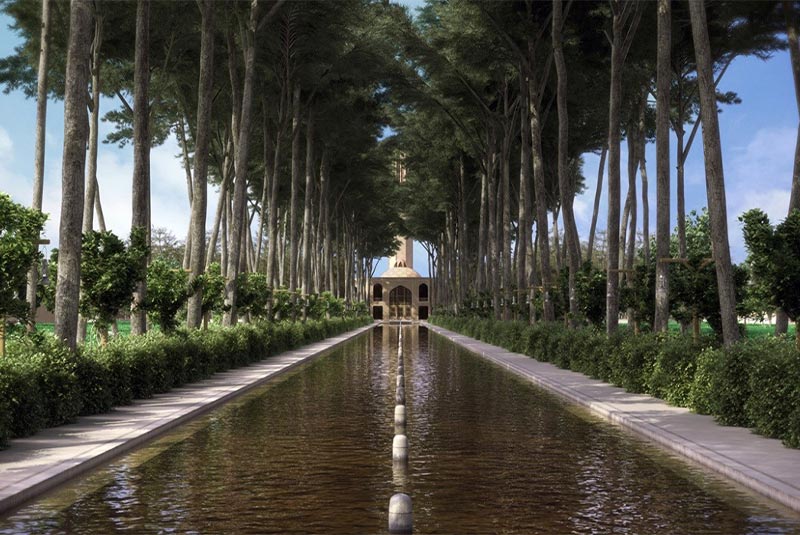
It was built in 1740 by Mohammad Taghi Khan, a governor of Yazd under the Zand era, and has a surface area of over 70,000 m2. In the middle of the park, between the octagonal summer and winter quarters, is the largest pool in Iran at 208 meters long, with 47 fountains. The winter pavilion faces south, allowing more natural light to enter. On the other side, the summer pavilion’s windcatcher, which rises 33 m into the Yazd city skyline and is reputed to be the largest of its kind in the world, is undoubtedly its most famous feature. The water was maintained at nearly freezing temperatures by this prehistoric natural ventilation system, which was a crucial component of dwelling buildings and other structures located in the desert.
The doors and windows of this structure are made of stained glass. One of the numerous functions of this vibrant glass is to obstruct the view from the outside. In addition to protecting carpets and other home furnishings from direct sunlight, they are supposed to deter mosquitoes, thanks to their reflections. Pomegranate, mulberry (one of which is claimed to be the complex’s oldest trees), and, to a lesser degree, fig, olive, and grape, are among the fruit trees and vines.
| Learn more: Discover the Most Famous Caves of Iran
5. Fin Garden in Kashan
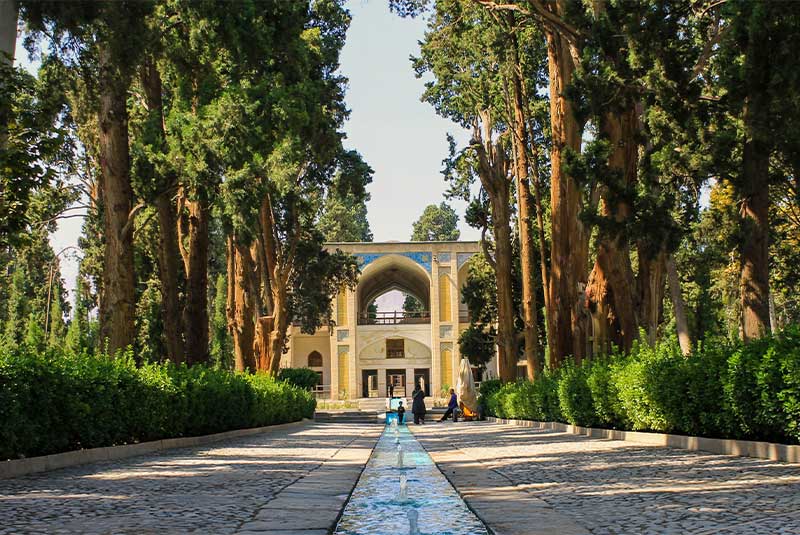
Bagh-e-Fin, or Fin Garden, is a pleasant respite from Kashan’s otherwise arid desolation. The oldest still-existing garden in Iran, Fin Garden, is a superb example of the chahar bagh element. The Safavid dynasty began construction on this garden in 1590, but the Qajar dynasty, which ruled from 1799 to 1834, is responsible for what is left of it now. Life was infused into Bagh-e-Fin from the neighboring Soleymanieh Spring. Its earliest occupancy dates to about 6000 and 5500 BCE. This area has historically been chosen by successive kings and administrations due to the presence of this adjacent spring.
The main pavilion’s beautiful architecture, which incorporates elements from the Safavid, Zandiyeh, and Qajar eras and is adorned with fresco paintings, plasterwork, woodwork, and stained-glass windows, is a testament to how Fin Garden evolved over time. Amir Kabir, a chancellor in the Qajar dynasty, was assassinated in the bathhouse, which is situated on the left side of the garden.
| Read more: Sarv-e Abarkuh (Cypress of Abarkuh)
6. Pahlavan Pour Garden in Mehriz
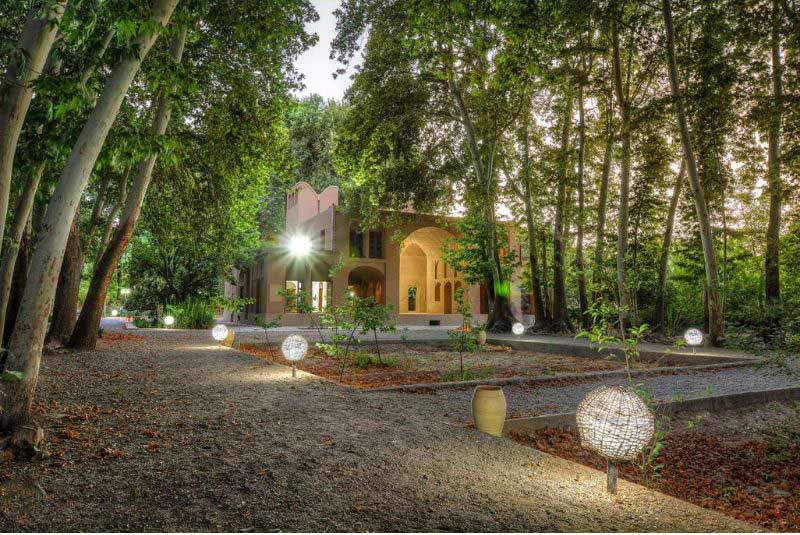
Bagh-e-Pahlavanpour, often known as “the garden town of Yazd,” is a town in Mehriz around 35 kilometers from Yazd. Although the majority of this 25,000 m2 garden’s architectural features date to the Zandieh period, the Qajar dynasty did build most of it. Ali Pahlevan, Hassan Mullah Reza’s son-in-law, acquired ownership of the land after Hassan Mullah Reza initially created it. The town’s noblemen previously resided in the summer and winter homes. The fact that three significant Qanats in Mehriz City—Hassanabad, Shah Hosseini, and Mazvir Abad—pass via the renowned Pahlavan Pour’s Garden—a mansion owned by a wealthy Yazdi merchant—is intriguing. The trees in the Pahlavan Garden are among its key characteristics.
Pomegranate, persimmon, and almond trees flourish in this garden despite the dry and warm environment of Yazd, and this is only possible because of the garden’s abundant water supply. The Pahlavan Pour Garden Complex is made up of a winter home, a caretaker’s house, a dormitory, a restroom, stables, a waterfall, and a central courtyard. From this garden, water rationing for other Mehriz gardens was previously planned. The water used to irrigate the garden comes from an SIS that enters via the southwest, passes through the Anjirak watermill to fill the basin and gutters, and then enters the Mirza Nasrollah watermill on the eastern end. Ornamental plane trees line the brooks that flow through the garden and water the area.
| Also might be interesting: Iranian Traditional Houses
7. Bagh-E-Shahzadeh Mahan, Kerman
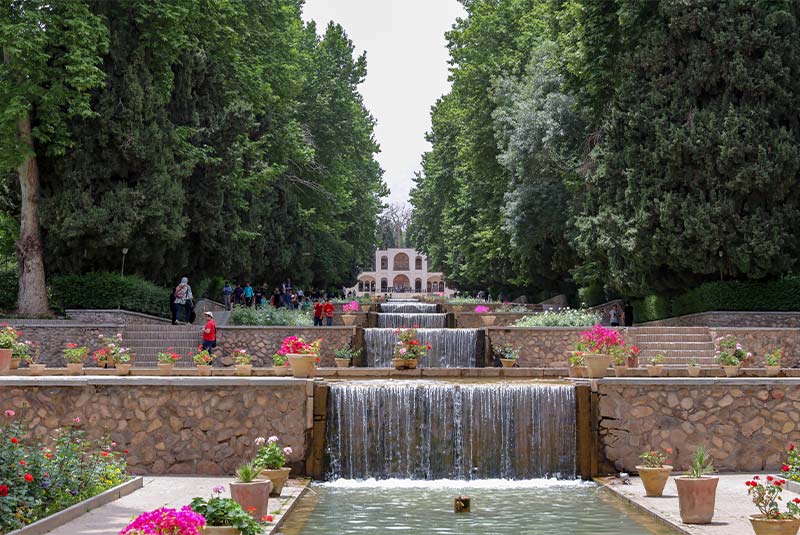
Bagh-e-Shahzadeh or Shazdeh (The Prince’s Garden) is a walled Eden of towering trees and flowing water that is situated in Mahan, some 35 kilometers southeast of Kerman. Mahan Gardens’ position in the middle of the desert, where it is well-known for its design, is one of its most notable characteristics. This 5.5-hectare garden has a 6.4% slope with a 20 m height variation from top to bottom and is situated on a hill.
The water pouring from the higher end to the lower end generates a symphony that is pleasing to the ear, and the fountains shooting water skyward are pleasurable to the eye as a result of this height difference. The water is transported longitudinally by the Tigran subterranean SIS from the adjacent town of Joupar. This garden has been able to thrive in an otherwise parched, inhospitable region owing in part to this SIS as well as the copious sunshine, rich soil, and gentle winds. The famed Yazdi architect Nasser al-Dawlah created and constructed this garden close to the main residence during the Qajar period.
8. Abbas Abad Garden in Mazandaran
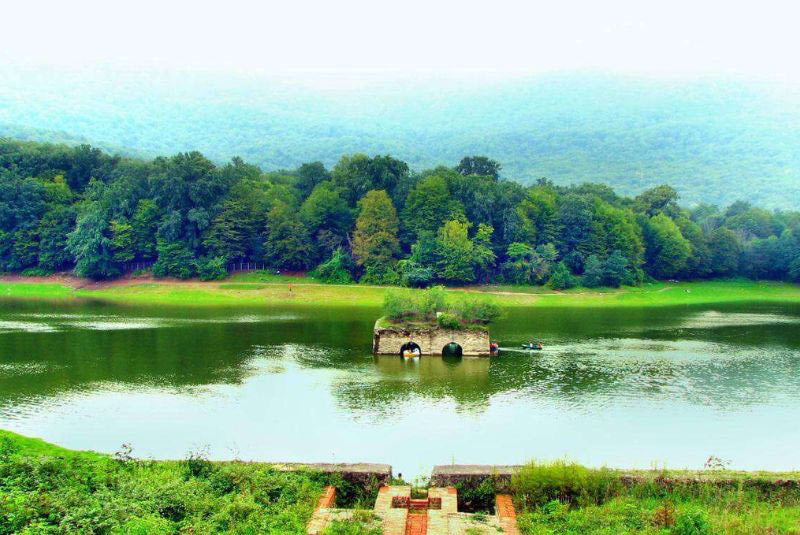
One of the most stunning and significant tourist destinations in the Mazandaran provincial city of Behshar is the Abbas Abad Garden. Due to the adequate vegetation and availability of trees in the area, northern Iran has historically received less attention when it comes to gardening and the design of green areas. However, the Abbas Abad Garden is the most significant garden in Iran’s north and in its non-arid environment.
Generally speaking, the Safavid and Shah Abbas eras were when the Abbas Abad complex in Behshahr was built. The Safavid architects dug a platform out of the mountains to build the Abbasabad Garden on, and they built a sloping garden utilizing Achaemenid methods. The clay pipes in the garden, which were intended to control water flow and produce music like those at the Taj Mahal and al-Hamra Palace, are its most remarkable feature. In the center of the garden, there is a lovely lake with an ancient dam. The lake receives its water from a spring and is connected by clay pipes to the royal fountains and pools.
| Discover: Takhte Soleyman | Throne of Solomon
9. Akbariyeh Garden in Birjand
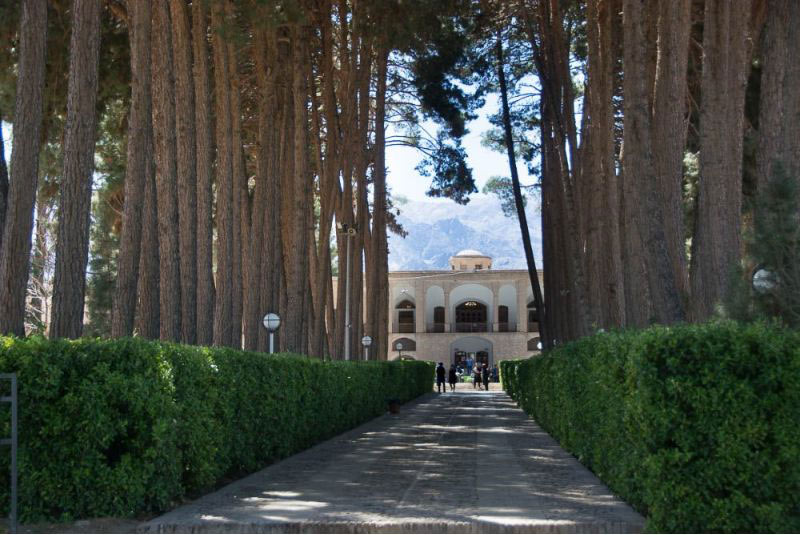
The 3.5-hectare Akribiyeh Garden in Birjand is another stunning Iranian garden that has been included on the UNESCO list. The Zandiyeh, Qajar, Pahlavi, and post-revolutionary eras are the four historical periods which experts split the history of the garden. This location in Birjand was significant enough to undergo several alterations to both its look and body throughout time. Birjand is regarded as the first Iranian city to have a pipeline and drainage system that was both old and vast. Birjand was acknowledged as one of the Great Khorasan Province’s vital cities during the rule of Zands (18th century).
The local king (Ali Akbar Khan Khazimeh) ordered the construction of a stunning and magnificent building next to the city’s aqueduct (Qanat) and on the slopes of Mount Bagheran in order to both flaunt his power and safeguard the city after the government and military began using the Baharestan citadel. At that time, a two-story mansion was constructed, with the first floor designated for visitors and government workers and the second floor designated for private life and visits. The Akbariyeh garden complex saw many additions during the Qajar and Pahlavi eras. Up until the end of 1996, the structure was unoccupied, but the same year, efforts were undertaken to register it with UNESCO as part of Iran’s national heritage. The Muqarnas Entrance, the main mansion, service areas, the three mansion entrances, the stables, and the courtyard are only a few of the garden’s diverse components.
| Learn about: Chak Chak Pilgrimage Site | A Cultural Gem in Central Iran
Bottom Line
The Persian garden is similar to heaven on Earth in many respects. A Persian garden, or Boustan, often has a rectangular shape with four quadrants that are each filled with trees and flowers. Persian gardens often have a central pavilion, streams and paths, ponds and fountains, and surrounding walls. Nine of the many Persian gardens are included on the UNESCO World Heritage Site due to their exceptional beauty. These gardens all share a similar general form despite being spread throughout several geographical regions of Iran with various temperatures and their own distinctive traits. If you are planning to visit Iran, we highly recommend that you not forget to put visiting these Persian Gardens on your schedule.


Comment
Leave a Comment